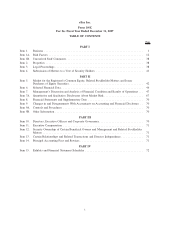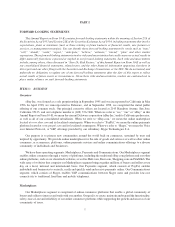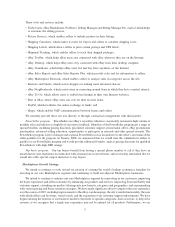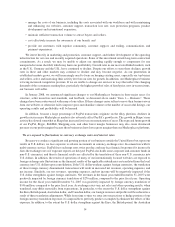eBay 2007 Annual Report Download - page 17
Download and view the complete annual report
Please find page 17 of the 2007 eBay annual report below. You can navigate through the pages in the report by either clicking on the pages listed below, or by using the keyword search tool below to find specific information within the annual report.or a payment to an individual in lieu of cash. Allowing new account holders to join the network when they make or
receive payments encourages PayPal’s natural, user-driven growth. PayPal’s account sign-up process asks each new
account holder to provide PayPal his or her name, street address, phone number and email address. The account
holder’s email address serves as the unique account identifier. PayPal also offers certain customers who sell on their
own websites the ability to accept credit card payments from buyers without requiring the buyer to open a PayPal
account.
Payment Transaction Overview
Buyers make payments at the PayPal website (including for items listed on eBay.com by sellers that accept
PayPal as a payment method), at other online businesses or platforms where the seller has integrated PayPal’s
Instant Purchase feature, or at the websites of merchants that have integrated PayPal’s Website Payments feature. To
make a payment at PayPal’s website, a buyer logs in to his or her account and enters the recipient’s email address
and the amount of the payment. To make a payment through Instant Purchase or Website Payments, a buyer selects
an item for purchase, confirms the payment information and enters his or her email address and password to
authorize the payment. The buyer chooses whether PayPal debits the money from the buyer’s PayPal balance, credit
card, or bank account and the payment is then credited to the recipient’s PayPal balance. In the case of an eCheck
payment, the transaction is held until the funds have cleared the sender’s bank, which typically takes three to five
business days. In turn, the recipient can make payments to others or withdraw his or her funds at any time via check
(in the U.S.), electronic funds transfer, or a PayPal-branded debit card (which is only available to U.S. users).
PayPal earns revenues in several ways. First, PayPal earns transaction fees when a Business or Premier account
receives a payment. Second, PayPal earns a foreign exchange fee when an account holder converts a balance from
one currency to another. Third, PayPal earns fees from merchants who utilize PayPal’s online payment processing
services. Fourth, PayPal earns fees when a user receives payments from outside the U.S. Fifth, PayPal may earn fees
when a user withdraws money to a non-U.S. bank account, depending on the amount of the withdrawal. Sixth,
PayPal earns a return on certain customer balances. Finally, PayPal may earn ancillary revenues from a suite of
financial products, described below.
PayPal incurs funding costs on payments at varying levels based on the source of the payment. Costs associated
with credit card and debit card funded payments are significantly higher than bank account or balance-funded
payments. U.S. account holders who choose to maintain PayPal balances in U.S. dollars have the ability to sweep
balances into the PayPal Money Market Fund. This Money Market Fund, which is invested in a portfolio managed
by Barclays Global Fund Advisors, bore a current compound annual yield of 3.62% as of February 14, 2008.
Verification of Account Holders
To fund payments from their bank accounts in the United States, account holders must first become verified by
PayPal. The primary method for verification is our Random Deposit technique. Under this technique, PayPal makes
two deposits ranging from 1 cent to 99 cents to the account holder’s bank account. To verify ownership of the
account, the account holder then enters the two amounts as a four-digit code at the PayPal website. In addition to
allowing funding through bank accounts, verification also removes some spending limits on account holders’
accounts and gives them reputational advantages when transacting with other members of the PayPal community.
Withdrawing Money
Each account holder in the U.S. and in 34 other countries may withdraw money from his or her PayPal account
through an electronic fund transfer to his or her bank account or, in the U.S., by a mailed check from PayPal.
Automated Clearing House, or ACH, withdrawals may take three to five business days to arrive in the account
holder’s bank account, depending on the bank. Anyone who can receive funds can make withdrawals to a U.S. bank
account. Mailed checks may take one to two weeks to arrive, and PayPal charges $1.50 per check. Qualifying
PayPal business users in the U.S. can receive a PayPal ATM/debit card, which provides these users with instant
access to their PayPal account balances. ATM/debit cardholders can withdraw cash, for a $1.00 fee per transaction,
from any ATM connected to the Cirrus or Maestro networks and can make purchases at any merchant accepting
MasterCard.
7
























